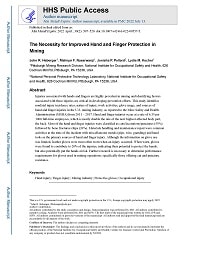Mining Publication: The Necessity for Improved Hand and Finger Protection in Mining
Original creation date: July 2022
Authors: J Heberger, M Nasarwanji, J Pollard, L Kocher
Injuries associated with hands and fingers are highly prevalent in mining and identifying factors associated with these injuries are critical in developing prevention efforts. This study identifies nonfatal injury incidence rates, nature of injury, work activities, glove usage, and sources of hand and finger injuries in the U.S. mining industry, as reported to the Mine Safety and Health Administration (MSHA) from 2011 – 2017. Hand and finger injuries occur at a rate of 6.53 per 1000 full-time employees, which is nearly double the rate of the next highest affected body part, the back. Most of the hand and finger injuries were classified as cuts/lacerations/punctures (53%) followed by bone fractures/chips (26%). Materials handling and maintenance/repair were common activities at the time of the incident with miscellaneous metals (pipe, wire, guarding) and hand tools as the primary sources of hand and finger injury. Although the information on glove use was limited, leather gloves were most often worn when an injury occurred. When worn, gloves were found to contribute to 20% of the injuries, indicating their potential to protect the hands, but also potentially put the hands at risk. Further research is necessary to determine performance requirements for gloves used in mining operations, specifically those offering cut and puncture resistance.

- Analysis of Fatalities During Maintenance and Repair Operations in the U.S. Mining Sector
- Design of Surface Mine Haulage Roads - a Manual
- Development and Evaluation of a Training Exercise for Construction, Maintenance and Repair Work Activities
- Hazard Recognition Training Program for Construction, Maintenance and Repair Activities
- Impact of Maintainability Design on Injury Rates and Maintenance Costs for Underground Mining Equipment
- Machine-Related Injuries in the US Mining Industry and Priorities for Safety Research
- Maintainability
- Reducing Machine Guarding-Related Injuries in Mining
- Risk Profile of Cumulative Trauma Disorders of the Arm and Hand in the U.S. Mining Industry
- Technology News 554 - ErgoMine Targets Ergonomics and Safety Issues in Mining